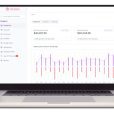With the average Sydney pile now worth more than $1 million – with a broken drain the only water view – it’s an odds-on bet that the next financial meltdown will have something (or everything) to do with housing.
Last week federal treasurer Josh Frydenberg and the powerful Council of Financial Regulators signalled a crackdown on the unfolding madness.
This followed the International Monetary Fund’s warning that the red-hot housing market threatened financial stability, with the august body recommending ‘macroprudential’ measures such as caps on high debt-to-income loans and loan-to-valuation ratios.
The Australian Prudential Regulation Authority on Wednesday responded by increasing the buffer rate – the presumed interest rate at which lenders must assess a borrower’s ability to pay – from 2.5 per cent to 3 per cent.
Factor in the marathon pandemic lockdowns and the ensuing unemployment and it’s no wonder the policymakers are worried.
As far as the ASX-listed home lenders go, there’s no sense of impending crisis but to avoid one will involve some defter credit assessment practices, such as much closer scrutiny of so-called ‘liar loan’ applications.
But it’s often OK until it’s not.
Home loan specialist Resimac (RMC) almost doubled net earnings to $107.6 million in the 12 months to June 30 2021, helped along in no small part by the bad debt charge falling to $2.7 million from $22 million previously.
The owner of Homeloans.com.au, Resimac raised a specific provision of $5.43 million – 0.04 per cent of the $13.8 billion loan book, compared with $6.06 million (0.05 per cent) a year ago.
Not surprisingly, the prime mortgages are doing better than the ‘specialist’ category (these are loans the mainstream lenders won’t take on, but can still be a good risk with the right treatment).
Resimac CEO Scott McWilliam says while there’s been an uptick in hardship applications, it’s not like it was 12 months ago and the mood is “rational”.
In its full-year numbers Liberty Financial (LFG) reported customers accounting for a mere $84 million of outstandings were subject to Covid-19 partial payment arrangements, compared with $1.133 billion the previous June.
Home loans account for 71 per cent of Liberty’s total lending book.
Liberty’s bad and doubtful debt charge dropped to almost nothing, thanks to the write-back of previous provisions that were not needed.
Fresh from its May IPO Pepper Money (PPM) notes that a year ago more than 12,000 customers had applied for a payment pause. As of this August the number had dwindled to 173 – so few you could almost name them individually.
“It’s startingly different,” CEO Mario Rehayem says.
He opines that customers are far better informed about what a repayment ‘holiday’ really means: like a normal vacation it won’t last forever and still has to be paid for eventually.
“Before there was a rush to the phone, [with borrowers] thinking they could forfeit their repayments and not have to pay it back,” he says.
It also helps that more customers have got a decent savings buffer to fall back on, the result of them not being able to avail of leisure activities and travel.
“Pre Covid, household savings were running at between 2 and 2.5 per cent (of disposable income),” says Pepper CFO Therese McGrath.
“Australians really got on top of their financials and the rate went up to 20 per cent and we’re still sitting between 11 and 13 per cent.”
In the June (first) half of 2021, Pepper’s loan losses stood at 0.28 per cent of the loan book, a 9 basis point improvement. Mortgages account for $11.3 billion of Pepper’s $14.3 billion loan book- 79 per cent – with asset (mainly vehicle) financing constituting the rest.
“Historically our loss performance has been good because of the disciplined way we issue credit,” Reyahem says.
“We are performing exceptionally well, but historically we have as well.”
At the top end, the experience of the Commonwealth Bank of Australia (CBA) emulates that of the non-banks, but with even lower losses.
The only Big Four bank to have a June balance date, the country’s biggest home lender reported a full-year loan impairment of $554 million – 0.07 per cent of the bank’s $817 billion lending book – compared with $2.518bn previously.
Home lending arrears accounted for $134 million, compared with $1.034 billion previously.
The bank’s overall bad debt provisioning stands at $6.2 billion (1.63 per cent of the book) relative to $6.4bn previously.
In its third quarter credit quality update, Westpac (WBC) – the second biggest home lender – reports 90 day mortgage delinquencies at 1.11 per cent of the book, compared with 1.62 per cent a year ago.
We’ll get a better idea when Westpac, the ANZ Bank (ANZ) and the National Australia Bank (NAB) report their full numbers for the year to September 30.
On the progress reports to date, there won’t be anything too big, hairy and scary – or not yet anyway.
On a pessimistic note, the hearty earnings chalked up by the aforementioned lenders are unlikely to be repeated if there’s a blowout in delinquencies from such rock-bottom levels.
On the brighter side, the lenders are using data to assess applications in a more customised way, rather than accepting or rejecting customers using cookie-cutter measures.
The data-driven measures should also help the lenders avoid problems of the past. Pepper, for instance, pays close attention to Covid affected local government areas and industries and won’t lend to purchasers of high rise apartments or lifestyle properties such as hobby farms.
Hopefully the lenders’ high tech tools are top shelf, because when (not if) interest rates rise their stress tolerance assumptions will be sorely tested.
In the last month, shares in Resimac, Pepper and Liberty Financial have declined 18 per cent, 11 per cent and 3 per cent respectively, while the the broader market has shed around 4 per cent. CBA shares have actually gained 3 per cent, despite the bank often being derided as the world’s most expensive building society.
It’s a moot point whether investors are correctly sniffing rising distress in the mortgage belt, or whether it’s another false alarm and the shares make for value buying into what’s been a Teflon-coated sector for so many years.
- Amid dazzling returns, is now the time to join the diamond hunt? - November 10, 2021
- Two listed ag stocks that promise a bounteous harvest for investors - November 3, 2021
- ASX-listed e-gaming stocks show promise but are they in the main event? - October 27, 2021












Leave a Comment
You must be logged in to post a comment.